And here is a video that demonstrates how the camera operates:
Sonntag, 28. Oktober 2007
First Light ;-)
Here are the first results from a short walk this morning:
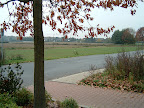
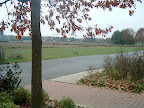


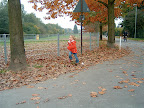
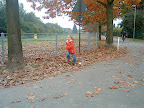
And here is a video that demonstrates how the camera operates:
And here is a video that demonstrates how the camera operates:
Measuring Synch
The easiest way to measure the synchronization of the cameras involved using my turntable with a corresponding scale:

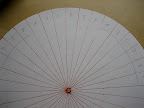
Setting the turntable to 45rmp means that a deviation of 10 degrees corresponds to a time-difference of 0,037 seconds.
Here is the first test shot:
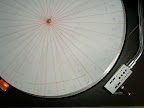
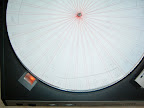
The time-difference is aproximately 0,015 seconds although the second camera has received some flash from the first.
What you also see is a significant deviation in the vertical direction, which means I have to adjust the rig accordingly. Time to work on the next post ... ;-)
Setting the turntable to 45rmp means that a deviation of 10 degrees corresponds to a time-difference of 0,037 seconds.
Here is the first test shot:
The time-difference is aproximately 0,015 seconds although the second camera has received some flash from the first.
What you also see is a significant deviation in the vertical direction, which means I have to adjust the rig accordingly. Time to work on the next post ... ;-)
Samstag, 27. Oktober 2007
Dismantling and Wiring the cameras
To allow for a good synchronization it is necessary to switch on the cameras exactly in parallel, therefore not only the shutter switch but also the on/off switch needs to be connected. In this project I did not couple the zoom switches as well, because the soldering points looked to delicate. I might try this in the future, though ...
Dismantling the cameras is pretty straighforward: You'll only need a size-0 Philips screwdriver. After unscrewing all three visible screws on the outside case:
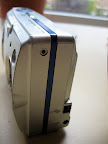
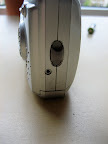
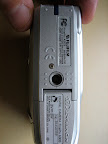
You are then able to carefully pull of the back-case:
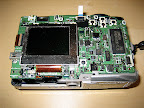
Be careful not to touch the solder-contacts between the LC-display and the micro-buttons on the right upper side as some of them lead to the flash-capacitor. If you touch this area you can get a severe shock! During my first investigation of this camera, I accidentally connected two of the contacts while measuring, which resulted in a small explosion and the need to buy another camera from Ebay. Apparently I destroyed the mainboard completely! If you want to be sure, you can discharge the capacitor using a corresponding resistor. But since we are only working with the shutter-board this is not a must. BTW a good description of the procedure to dismantle the camera can be found here.
To couple the cameras we need to solder some wires to the shutter-board which is connected to the mainboard via a flex-cable that can be disconnected after unlocking one of the connoctors:
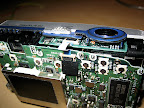
Before you are able to reach the shutter-board, you need to pull-out the mainboard with the optical-unit. To this end you need to unscrew the screw below the LC-display. The LC-display can be disconnected after unlocking the flex-cable connector. After that you can carefully pull-out the whole assembly.
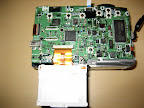
Now you can disconnect the shutter board. The interesting contacts are shown in the next picture:

I decided to use a direct connection between both cameras. An easy way to route the wires out of the camera was to use the hole for the power-connector which I did not plan to use anyway, because I have a stand-alone charger for my batteries. This meant that I had to unsolder the power-socket first:
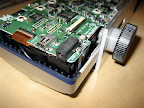
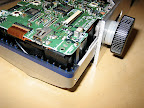
I then prepared a flat-flex cable with 5 leads (2 for power-switch, 3 for focus, shutter and common ground) and routed this though the back-cases:
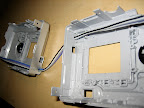
The easiest way to route the cable within the camera appeared to be as follows:
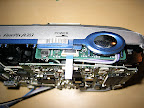
The soldering requires a small soldering-tip and fairly shake-free hands but if I can do it (being a theoretical(!) physicist by education), then anybody can do it ;-)
I did not use the common-ground on the shutter-board, but found that one of the contacts for the battery socket that I had removed was also connected to ground, so I used that one and therefore needed only to route 4 wires completely through the camera to the shutter-board.
After re-assembling the camera and performing a simple test, the camera did not power-up. After several frustated minutes I found out the reason: The battery-connector that I removed also provided a connection between two soldering-pads that now, of course, was missing. My initial inspection suggested that one of the pads was not connected to anything, so I didn't care but apparently I was wrong. I solved the problem by adding an additional wire-bridge to this contact:
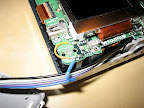
Now the camera started to work as usual and so I reassembled it. I now did exactly the same with the second camera and after reassembling everything and mounting both cameras on the rig this is the final result:
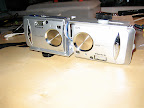
First test shots looked good. Hoepfully I will start the first serious testing tomorrow.
Dismantling the cameras is pretty straighforward: You'll only need a size-0 Philips screwdriver. After unscrewing all three visible screws on the outside case:
You are then able to carefully pull of the back-case:
Be careful not to touch the solder-contacts between the LC-display and the micro-buttons on the right upper side as some of them lead to the flash-capacitor. If you touch this area you can get a severe shock! During my first investigation of this camera, I accidentally connected two of the contacts while measuring, which resulted in a small explosion and the need to buy another camera from Ebay. Apparently I destroyed the mainboard completely! If you want to be sure, you can discharge the capacitor using a corresponding resistor. But since we are only working with the shutter-board this is not a must. BTW a good description of the procedure to dismantle the camera can be found here.
To couple the cameras we need to solder some wires to the shutter-board which is connected to the mainboard via a flex-cable that can be disconnected after unlocking one of the connoctors:
Before you are able to reach the shutter-board, you need to pull-out the mainboard with the optical-unit. To this end you need to unscrew the screw below the LC-display. The LC-display can be disconnected after unlocking the flex-cable connector. After that you can carefully pull-out the whole assembly.
Now you can disconnect the shutter board. The interesting contacts are shown in the next picture:

I decided to use a direct connection between both cameras. An easy way to route the wires out of the camera was to use the hole for the power-connector which I did not plan to use anyway, because I have a stand-alone charger for my batteries. This meant that I had to unsolder the power-socket first:
I then prepared a flat-flex cable with 5 leads (2 for power-switch, 3 for focus, shutter and common ground) and routed this though the back-cases:
The easiest way to route the cable within the camera appeared to be as follows:
The soldering requires a small soldering-tip and fairly shake-free hands but if I can do it (being a theoretical(!) physicist by education), then anybody can do it ;-)
I did not use the common-ground on the shutter-board, but found that one of the contacts for the battery socket that I had removed was also connected to ground, so I used that one and therefore needed only to route 4 wires completely through the camera to the shutter-board.
After re-assembling the camera and performing a simple test, the camera did not power-up. After several frustated minutes I found out the reason: The battery-connector that I removed also provided a connection between two soldering-pads that now, of course, was missing. My initial inspection suggested that one of the pads was not connected to anything, so I didn't care but apparently I was wrong. I solved the problem by adding an additional wire-bridge to this contact:
Now the camera started to work as usual and so I reassembled it. I now did exactly the same with the second camera and after reassembling everything and mounting both cameras on the rig this is the final result:
First test shots looked good. Hoepfully I will start the first serious testing tomorrow.
Construction of the Aluminum Rig
The rig was made of standard aluminium U-Profile (forgive me if that is not the correct technical term in english). As a counterexample to Murphys Law I was able to find it with almost exactly the right size to accomodate two cameras.
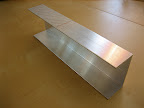
After measuring the size of the cameras I came up with the following diagram:
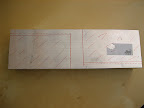
Using a standard jigsaw I then ended up with the following rig:
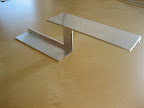
To be able to attach the camera with a variable stereo-base, I needed slot-holes. Having only a drill and rasps this turned out to be a rather tedious job, but after 2 hours the result looked okay:
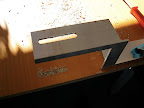
Finally using two standard camera screws, the rig was finished.
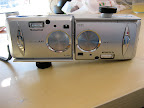
After measuring the size of the cameras I came up with the following diagram:
Using a standard jigsaw I then ended up with the following rig:
To be able to attach the camera with a variable stereo-base, I needed slot-holes. Having only a drill and rasps this turned out to be a rather tedious job, but after 2 hours the result looked okay:
Finally using two standard camera screws, the rig was finished.
The camera
After a few weeks of planning, I decided to use the Fuji A303 as a basis for my digital stereo rig. One reason was that these cameras are readily available on Ebay for around 30-35 €. So even if this project would be a total failure, the risk is limited to around 80-90 €. Another reason was, that the lens of this camera is very close to the left edge of the case, so building a rig with one camera upside down would result in a stereo-base of only 4-5 cm.
To give you an idea what the final result looks like, here is a picture of the rig (although before the wiring was completed):

To give you an idea what the final result looks like, here is a picture of the rig (although before the wiring was completed):
Abonnieren
Kommentare (Atom)